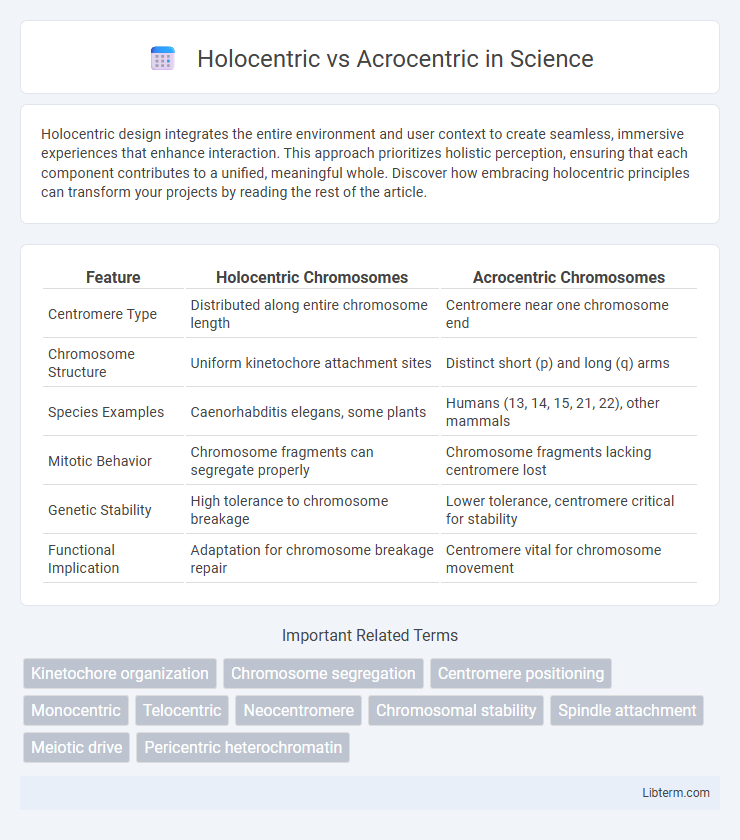Holocentric design integrates the entire environment and user context to create seamless, immersive experiences that enhance interaction. This approach prioritizes holistic perception, ensuring that each component contributes to a unified, meaningful whole. Discover how embracing holocentric principles can transform your projects by reading the rest of the article.
Table of Comparison
| Feature | Holocentric Chromosomes | Acrocentric Chromosomes |
|---|---|---|
| Centromere Type | Distributed along entire chromosome length | Centromere near one chromosome end |
| Chromosome Structure | Uniform kinetochore attachment sites | Distinct short (p) and long (q) arms |
| Species Examples | Caenorhabditis elegans, some plants | Humans (13, 14, 15, 21, 22), other mammals |
| Mitotic Behavior | Chromosome fragments can segregate properly | Chromosome fragments lacking centromere lost |
| Genetic Stability | High tolerance to chromosome breakage | Lower tolerance, centromere critical for stability |
| Functional Implication | Adaptation for chromosome breakage repair | Centromere vital for chromosome movement |
Introduction to Chromosome Structures
Holocentric chromosomes feature multiple kinetochores along their entire length, enhancing spindle attachment during cell division, while acrocentric chromosomes possess a single centromere located near one end, creating a distinct short (p) arm and a longer (q) arm. The structural differences influence chromosome behavior in mitosis and meiosis, affecting genetic stability and segregation mechanisms. These variations are critical for understanding chromosomal organization and evolutionary adaptations across species.
Defining Holocentric Chromosomes
Holocentric chromosomes are characterized by having centromeric activity spread along their entire length, unlike acrocentric chromosomes that possess a single, localized centromere near one end. This unique feature of holocentric chromosomes allows for distinct patterns of chromosome segregation during cell division, providing evolutionary advantages in certain species such as nematodes and some plants. Understanding the structural differences between holocentric and acrocentric chromosomes is crucial for studies in cytogenetics and genome stability.
Characteristics of Acrocentric Chromosomes
Acrocentric chromosomes possess a centromere located near one end, resulting in a distinctively short p arm and a long q arm, which differentiates them from holocentric chromosomes that have diffuse centromeres along their entire length. These chromosomes often contain nucleolus organizer regions (NORs) on their short arms, responsible for encoding ribosomal RNA and contributing to nucleolus formation. Common examples of acrocentric chromosomes in humans include chromosomes 13, 14, 15, 21, and 22, which are known for their role in Robertsonian translocations.
Differences Between Holocentric and Acrocentric Chromosomes
Holocentric chromosomes possess centromeric activity distributed along their entire length, allowing spindle fibers to attach at multiple points during cell division, while acrocentric chromosomes feature a single localized centromere near one end. This structural difference results in distinct behaviors during mitosis and meiosis, with holocentric chromosomes enabling more flexible chromosomal breakage and fusion without loss of centromere function. Additionally, holocentric chromosomes are commonly found in plants like Luzula and certain nematodes, whereas acrocentric chromosomes are typical in humans and other mammals, characterized by a short p arm and long q arm.
Evolutionary Significance of Centromere Types
Holocentric chromosomes, characterized by centromeric activity distributed along their entire length, provide evolutionary advantages by enhancing stability during cell division, especially in species with high rates of chromosomal rearrangements. Acrocentric chromosomes possess a localized centromere near one end, which facilitates specific chromosomal behaviors such as Robertsonian translocations, contributing to karyotype evolution in mammals. The contrasting centromere architectures influence genome plasticity, adaptation processes, and speciation by dictating mechanisms of chromosomal segregation and rearrangement.
Chromosome Behavior During Cell Division
Holocentric chromosomes exhibit centromeric activity along their entire length, allowing spindle fibers to attach at multiple sites during cell division, which ensures balanced chromatid segregation. Acrocentric chromosomes contain a singular, localized centromere near one end, creating a primary constriction where spindle fibers attach, guiding typical chromatid separation. The dispersed kinetochore distribution in holocentric chromosomes contrasts with the localized kinetochore in acrocentric chromosomes, impacting their structural dynamics and stability during mitosis and meiosis.
Holocentric Chromosomes in Nature
Holocentric chromosomes, characterized by their diffuse centromere activity along the entire chromosome length, contrast sharply with acrocentric chromosomes that have a single localized centromere. These holocentric structures are predominantly found in certain plant species like Luzula and some insects including nematodes such as Caenorhabditis elegans. Their unique centromeric organization provides increased stability during cell division and allows resilience to chromosomal breakage, facilitating evolutionary adaptations.
Acrocentric Chromosomes in Human and Animal Genetics
Acrocentric chromosomes, characterized by a centromere positioned near one end, are prominent in human genetics, specifically chromosomes 13, 14, 15, 21, and 22, which are known for containing nucleolar organizer regions vital for ribosomal RNA synthesis. In animal genetics, acrocentric chromosomes play a key role in chromosomal behavior and evolution, often involved in Robertsonian translocations that impact fertility and speciation. Their distinct morphology contrasts with holocentric chromosomes, where centromere activity is distributed along the entire chromosome length, influencing genetic stability and inheritance patterns.
Implications for Genetic Disorders and Mutations
Holocentric chromosomes, which have diffuse centromeres along their entire length, exhibit greater stability during cell division, reducing the likelihood of chromosomal mis-segregation that often leads to genetic disorders. In contrast, acrocentric chromosomes, with a single centromere positioned near one end, are prone to Robertsonian translocations, a type of chromosomal rearrangement associated with conditions like Down syndrome and certain infertility cases. Understanding these structural differences is critical for assessing mutation risks and developing targeted genetic therapies.
Future Research and Applications in Cytogenetics
Future research in cytogenetics aims to elucidate the structural and functional distinctions between holocentric and acrocentric chromosomes, enhancing chromosome behavior understanding during cell division. Advances in genomic sequencing and imaging technologies will enable precise mapping of centromere activity in holocentric chromosomes, facilitating studies on chromosome segregation errors linked to diseases. Applications may include developing targeted therapies for chromosomal disorders and improving plant breeding strategies by exploiting holocentric chromosome stability.
Holocentric Infographic

 libterm.com
libterm.com